This is the second trip to the city of Nanjing. The sights to be visited this time round are mostly within the city centre. We departed the train station at 1.15pm and begin our journey to the first stop, the Da Qiao Garden (大桥公园). On our way there by cab, I came upon this interesting phrase in Chinese. Bearing witness to it is better than hearing it a hundred times, this very much brings out the reason why I make it a point to travel whenever I'm free. The knowledge and history that I have read from books all come alive when I am physically there; seeing it for the first time. Which brings us to our first stop, the Chang Jiang Bridge (长江大桥). 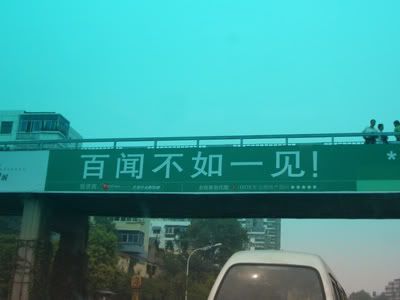
There is actually an amazing story behind the construction of the bridge. It was one of the first engineering marvel by the Chinese. It was constructed in the late 50s using Chinese designs and engineering. Given the difficulty of such a task across the impossible terrain of the river, it has also been a great source of nationalistic pride. The more recent engineering marvel undertaken by the Chinese includes the Three Gorges Dam and the Qinghai-Tibetan railroad.The easilest way to get to the bridge is via the Da Qiao Garden (大桥公园) as recorded in the travel books. It cost 15RMB in all to get through the park and to the top of the bridge. At the side of the bridge are quotes by Chairman Mao: "Only people are the drivers of world history" This is a double-decker bridge where cars travel at the top while train lines at the first level link the two sides up.
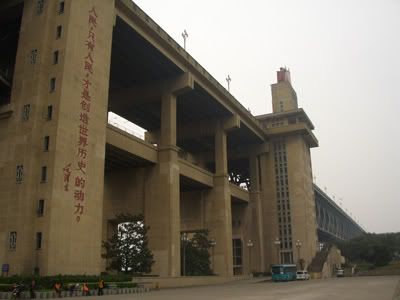
At the ground floor of the bridge is a large statue of Chairman Mao hailing to all.
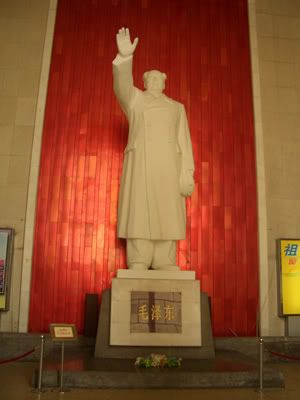
We took the lift to the '4th floor' which gives us a view of the bridge as well as the ongoing traffic. From afar, there are 2 statues (shown in the picture below), two at both end of the bridge. It shows the united and revolutionary strength of the chinese nation when the bridge is constructed.
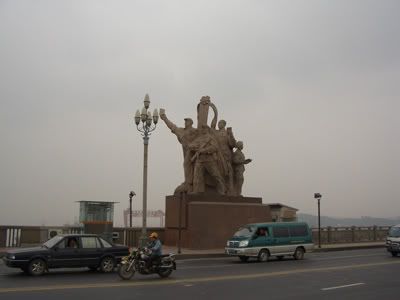
Along the bridge, there are iron paintings which visionise the future of the Chinese nation. One of such picture is capture below which shows a dam generating energy for the future.

We walked a bit down to the middle of the bridge. The Chang Jiang river is vast and is still widely used for the transportation of goods.
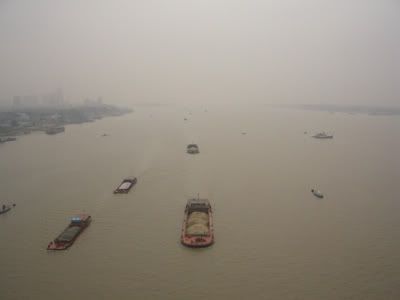
After we have taken all the shots of the Chang Jiang river, we proceeded on to our next stop, Cao Tian Gong (朝天宫). This is where the children of the officials are educated. A statue of Confucius at the entrance welcome visitors to this place of learning.

Cao Tian Gong is more of a museum dedicated to Zheng He (郑和) and city of Nanjing. In it showcase the development and history of the city over the millenniums.
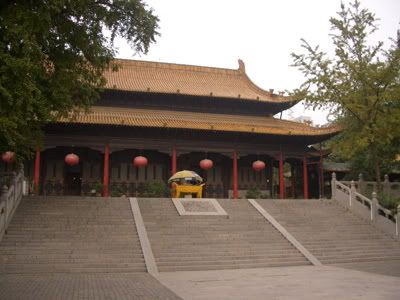
To the sides of Cao Tian Gong are markets which sell antiques and intriguing asian artifacts. It is really a 'China shop' where all kinds of ancient peripherals can be found.
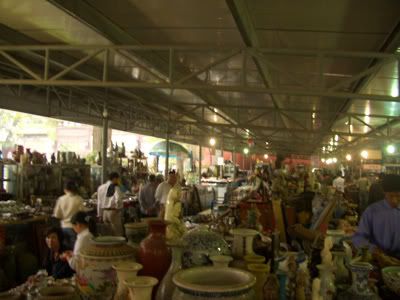
The next stop is Zhong Hua Gate (中华门) which is the largest gate in Nanjing city. This gate has been here since the Ming dynasty. There are 4 entrances to this gate, making it one of the most defensive gate in the whole city.
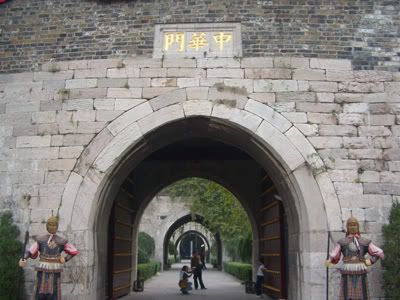
There are ramps at both sides of the gate which allow horses to rapidly travel to the top. I joined in one of the guardsman in their lookout.

It is said that the gate can hold up to 3,000 men at the many caves. Some of the ancient defensive weapons are on showcase in there.
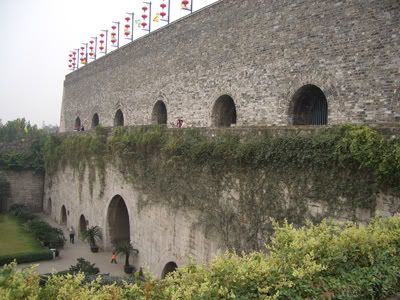
As time is running out, we have to skip the Ming Gugong (明故宫) to the east of the city. When we arrived at Fuzi Miao, it is already 5pm. The sun is setting fast and we are going on to our final day stop for the day - Fuzi Miao. Along the way, we got some snacks from the many hawkers and eateries that line the way to the temple. The unique feature of the temple is that it is surrounded by towering skyscrapers and modernity.
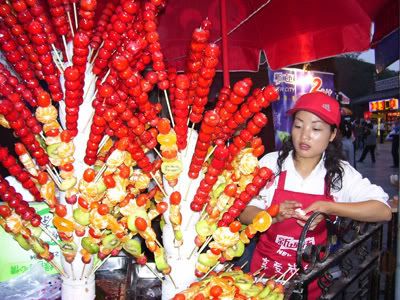
Here is a benevolent statue of Confucius. The incense smoke gives it a heavenly feel.
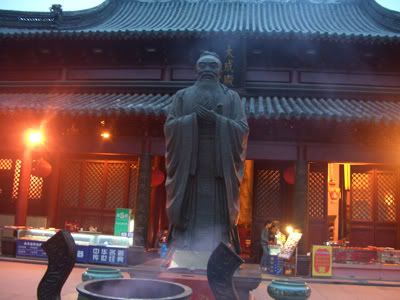
Coincidentally, a German tour group has requested for a chinese classical performance. We join in and catch the entire display. A short clip of the performance is shown below.
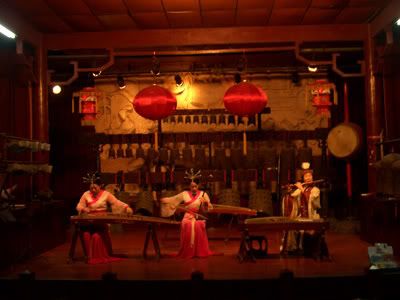
It is 6.45pm when we have finished our dinner. And our night visit has just began, this time to the modern business and shopping district at the heart of Nanjing - Xin Jie Kou (新街口). Here we have the tallest building in the area.
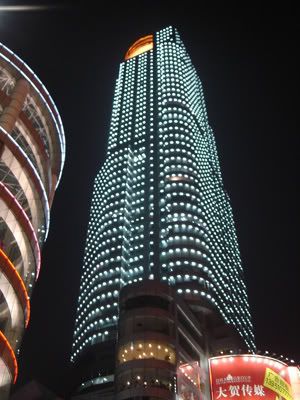
I asked the driver about the statue of Sun Zhong San at the roundabout in the middle of Xin Jie Kou which has been noted in all the travel guide books. He told me that it is no longer there. I was quite surprised! And he remarked that it has been moved 20 years ago to the Zhong San mausoleum!! Here is a photo shot of the current Xin Jie Kou roundabout.
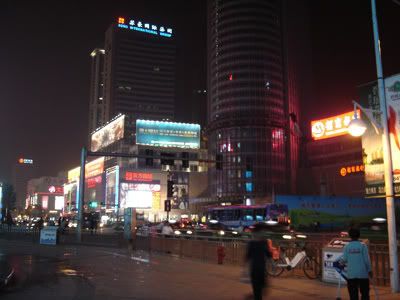
And finally we are back to the Nanjing station. It is here we sat down and reflect the skyline of the Nanjing cityscape. We cleared 5 of the 8 stops designated for the day. I guess we started a bit too late. As the sunset is getting earlier as days go by; as of this writing, the sunset time is 5.30pm. Future trips will start earlier at 6am or 7am and will end when the sun sets.
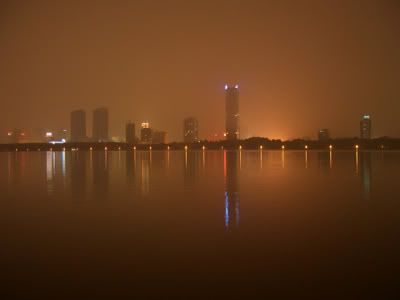
The main sights to be covered for this trip are those in Zi Jin Shan (紫金山); which is at the outskirts to the east of Nanjing city. We alighted at Nanjing West station (which is around 10 minutes down the main Nanjing station). The journey took us 2 hrs 15 mins in all from Wuxi at a cost of 33RMB. This is the slower train as compare to the faster one which will take around 2 hrs. We got out of the station and bought the 8.15pm return ticket (44RMB), which departs at the main train station. The time is 12pm when officially begin our tour. Based on the map, we should be able to catch a view of Chang Jang (长江) and the famous bridge (长江大桥) at just a 5 minutes walk away from the West station. It was quite disappointing when we got to the edge of the river as the view is blocked by high walls which demarcate the piers from the main roads. We walked parallel to the walls till we got to the passenger pier at Zhong Shan Pier (中山码头). Thereafter it is a cab ride to our next stop to the South: The Nanjing Massacre museum (南京大屠杀记念馆). When we were about a minute away from our destination, the driver suddenly recalled the museum is closed due to the ongoing subway construction works. We alighted nevertheless at the museum for a few photo shots. I asked one of the museum caretakers sitting next to the gate on the reopening date. She replied that it will be sometime end of next year (that is 2007!!!). I guess they aren't that particular about this memorial as the subway works is given the main priority. 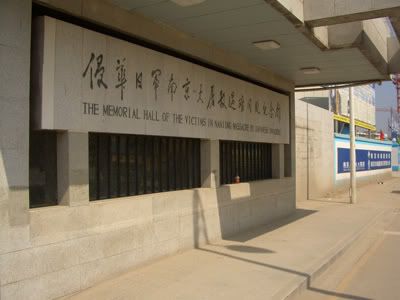
We took the cab eastwards out of the city area. And passed one of the many gates of Nanjing (which has survived since the Ming dynasty), the Zhong Shan Gate (中山门).
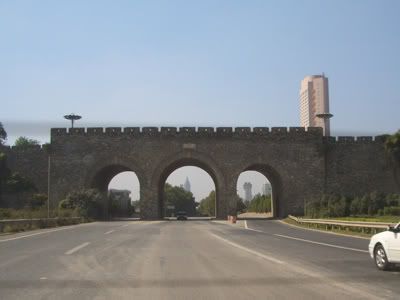
Our first stop for the day at Zi Jin Shan is Ling Gu Si (灵谷寺). We had a quick lunch at the entrance before getting the combine ticket for all the main sights of Zi Jin Shan at a cost of 130RMB. There are quite a number of people peddling cheaper tickets around the entrance, but we skipped them all.
A beautiful lake greeted us past the entrance. The captivating feature of the lake is the multi-coloured trees that surround it. There is actually a history behind it. In which the first emperor of the Ming dynasty ordered ten thousand man to create this lake after noticing the plain entrance to the temple. Thus the lake is call Wan Gong Ci (万工池). I joined in with the rest of the visitors and set my sights upon the tranquil lake.
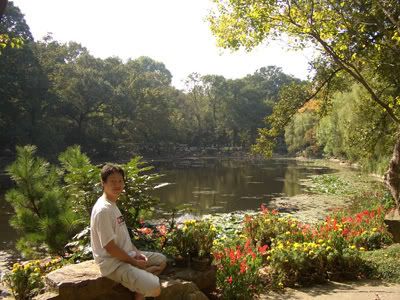
Through the temple gates, the first main hall is Wu Liang Dian (无梁殿). This is the oldest temple structure in the monastery. The rest are all burned down in the last century. It is pretty obvious why this hall is able to stood the test of time. It is made entirely of brick. This hall was used for keeping sutras and other treasures.
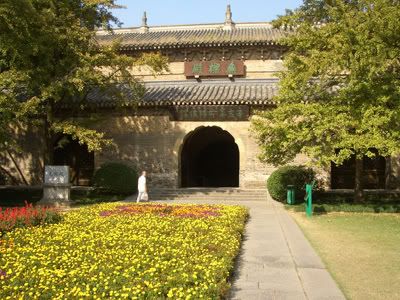
Here is a sneak peek into the inner walls of the halls. It reminded me of those European Catholic monasteries, or a granary where wine are kept for centuries. Now the hall is used as a memorial museum for people who died in the chinese revolution.
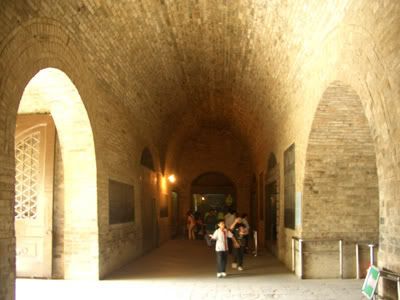
Through the stone hall and to the east is the main temple hall in the monastery. An additional 20RMB has to be paid to visit this temple hall. A relic of the Great Tang monk, Xuan Zang is kept in there.
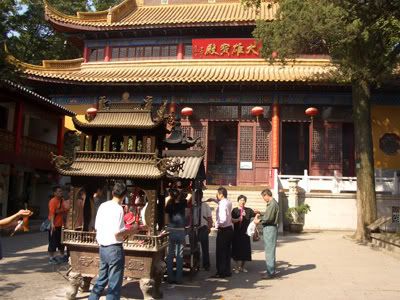
As no photos are allowed on the main relic, I took a snapshot of one of the wooden carvings on the temple wall. It shows a determined Master Xuan Zang who travelled to India in search of the Buddhist teachings.
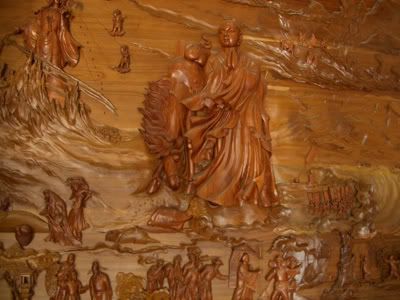
Once past the main hall is the final destination in Ling Gu Si - the Ling Gu pagoda. The pagoda was also built in the last century as a memory for those who lost themselves in the Chinese revolution. It is 9 stories high. We took the challenge and went all the way up to the top.
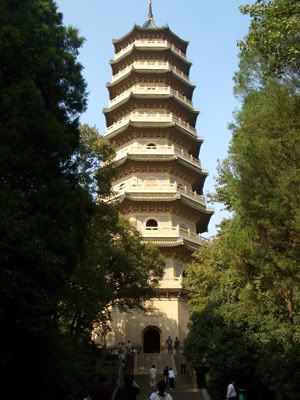
I noticed each storey is repesented by a traditional way of chinese representation. Here we have for level 6.
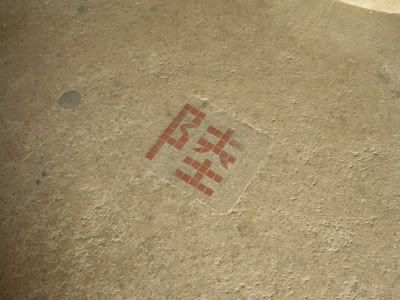
At the top of the pagoda we have a paranomic view of Nanjing city to the West and the surrounding mountain top. We caught sight of the Zhong Shan memorial below, which is our next stop.
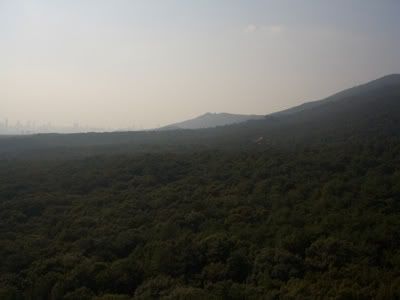
We continue westward by foot. After a 10 minutes walk through the forested track. We arrive at the Sun Zhong San memorial museum. In it showcase the life of the father of modern china as well as the turbulent times of China in those days.

It rounded off showing the vast economic development and achievements China has achieved, which is in line with the vision of Dr Sun.
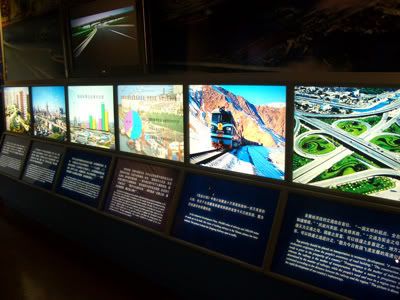
Our combine ticket also grant us entrance to the Academy of Dr Sun Zhong Sun which exhibits a variety of works by Dr Sun. We walked through the academy in 5 minutes and proceeded on our journey westward.

Before the Zhong Shan Mausoleum, there is a forum where people can just laze around and feed the many birds that lives there.
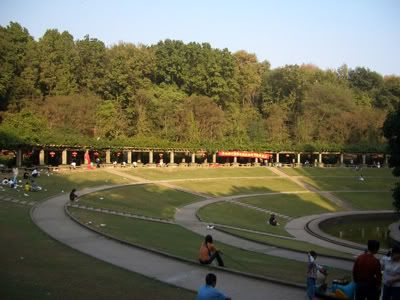
I managed to get a quick snap of a flock of birds flying to the top of the stage.
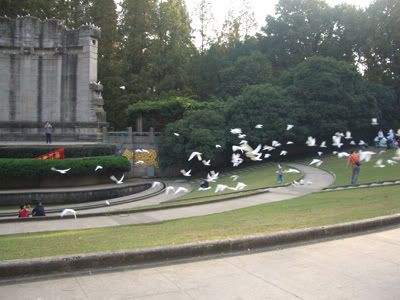
And here we are at the Zhong Shan mausoleum. To get to the main hall, visitors have to scale the three hundred over steps.
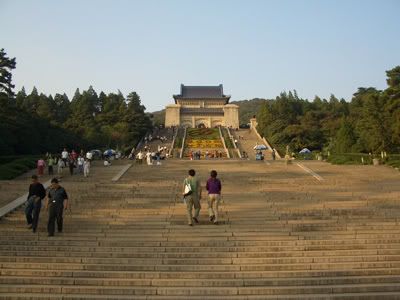
At the top of the memorial, it gives a picturesque view of the surroundings. In the main hall showcase the statue of Sun Zhong San and at the back hall is the main tomb of Sun Zhong San.

After visiting the Zhong Shan mausoleum, we are now going on to our final destination. It is the tomb of the first Ming emperor, Zhu Yuan Zang. The time now is 4.30pm and we have to fasten our pace to the final stop. We decided not to wait for the free shuttle train as we may just have missed it. The walk there is around 15 minutes in all.
A series of entrances lead to the main tomb. The one below actually demarcates the mortal world to the nether world.
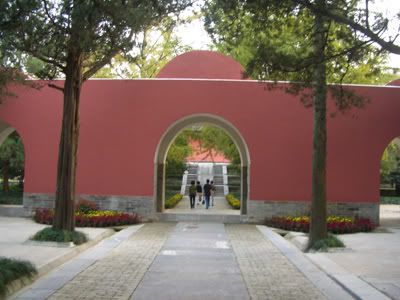
It is said the actual entrance to the Ming emperor tomb follows a peculiar 'C' shape instead of a straight road towards it (as seen in the picture below). The entrance from Zhong Shan mausoleum begins somewhere at the end of the C junction, so we are approaching the tomb fast.
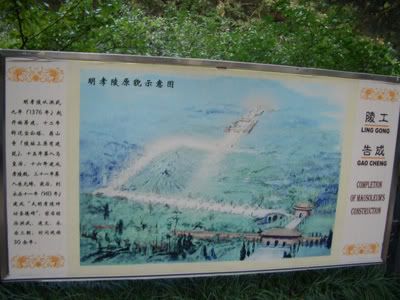
A towering fortress greeted us when we are nearing the tomb. It looks really ancient with a dark passage way leading in.
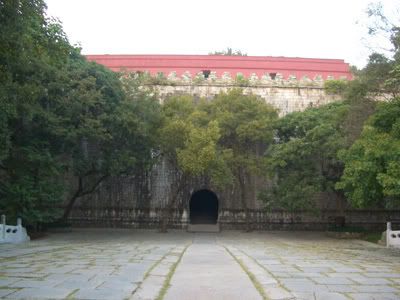
At the end of the dark passage is actually a forested path up the hill. It is said the Ming emperor tomb is somewhere in this hill. So we started climbing up the hill. The entire walk takes 30 minutes in all and is extremely exhausting. We circle the parimeter of the hill once we have scale it. To our side is a long continuous wall which leads back to the fortress. The sun is setting and it is really spooky to be walking through the forest at this time.
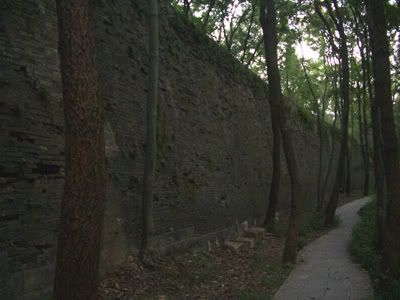
Finally we departed the fortress and is racing against time to reach our final stop in Zi Jin Shan. The actual C entrance to the tomb. It has been shown in the pictures that statues line the path to it. The picture taken below is using a night scene shot. In reality, it is extremely dark and is barely illuminated by the street lamps.
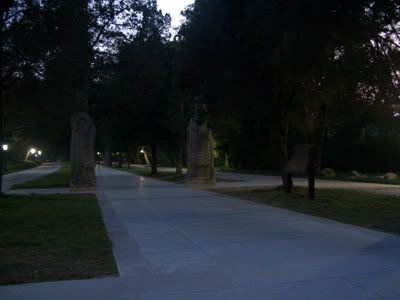
We took a bus out to the nearest station as we have difficulty hailing a cab at this time. From the bus station we took the cab to the Da Qiao. The driver dropped us at the start of the bridge and told us to walk straight up in order to catch a view of the bridge. After walking 10 minutes or so, we find it to be too far away. Here is a photo shot of the bridge at night just before we made a U-turn.
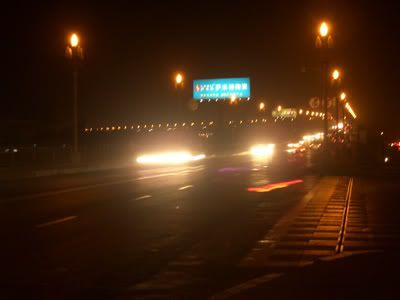
And finally we are back to Nanjing station after a whole day of walking and adventure in the nature park of Nanjing.
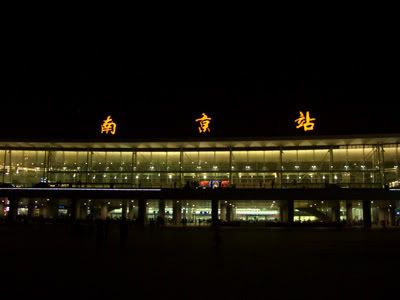
We were involved in an unfortunate car accident on our departure day. Well, it was our car that started it against two unfortunate mini-vans to the front. There was quite a noticeable dent on their side while our car managed to escape with a few scratches to the front (it is of BUICK-made). At the time of accident, all the vehicles on the road are pretty much bumper to bumper, compounded by the fact that our driver was feeling sleepy at that time.
Once the accident has happened, the negotiations started on how it should be resolved. The sum in dispute ranges from 600RMB to 1200 RMB. The road maintenance crew came in to help and finally the police was roped in until a settlement was reached. All in all, we were delayed by over an hour, with us reaching the airport at 3.30pm; 3.50pm is our flight departure time.
The check-in counters were closed and we have to pushed our flight to the next available timing at 11.50pm. That leaves us with 8 hours of free time.
This is a splendid opportunity to explore Shanghai (again)!!!
And the chance to ride the legendary Maglev.
We were pretty much shown the way to the Maglev station. A two-way ticket cost 80RMB, as against a single trip which is 50RMB. We bought the return ticket, and the staff informed us that the last train departs from Shanghai at 9pm.
There was quite a large crowd waiting outside the ticket gates and we went in together. From their conversations, I found out they were Japanese.
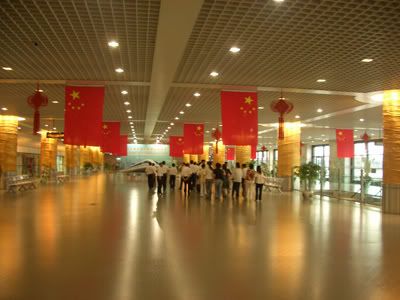
Here is a snapshot of the MagLev, it means Magnetic Levitation for short.
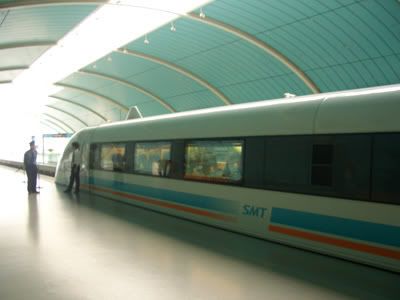
The train is pretty packed and we were one of the last few that got in.
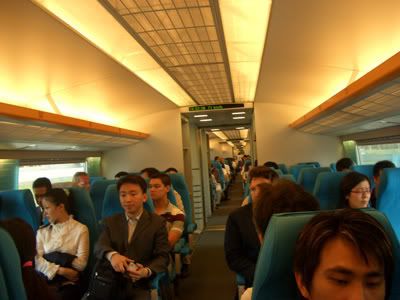
And here we go. It takes 40 minutes by car to reach Shanghai city but the Maglev is able to accomplish that in 8 minutes. The maximum speed attainable by the Shanghai Maglev is 430 km/hr. Below is a short clip of the view outside, it is really fast!!
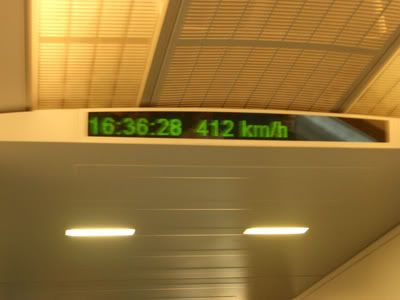
The train start to decelerates shortly after it has reached the maximum speed of 430 km/hr. The station we alighted is at the suburbs of Shanghai. To get to the main city area, we have to take the MRT which is just next to the MagLev station. It is another 15 minutes for us to get to Shanghai central. The station we are alighting is at Shimen Yi Road. It is just next to Nanjing West Road.
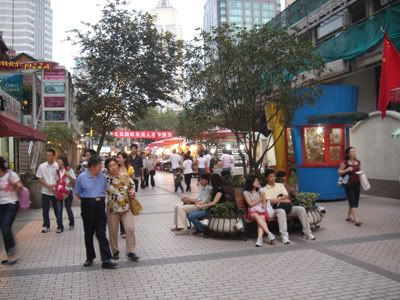
Shimen Yi road is famous for its shopping streets and food. We are here for the second reason, to go for the famous Xiao Long Bao. It is my second time here, so I am kind of bringing my friend here for the first time.
The chefs are busy at work preparing all the Xiao Long Baos. During normal lunch, dinner and over the weekends, there will always be long queue and it will be quite a challenge to get a seat in the restaurant.

Since it is only 5.30pm, we managed to get a seat easily. After our meal, we went on to Tao Bao City which is just a 5 minutes walk away. While showing my friend around, I can’t resist the temptation of doing some light shopping there.
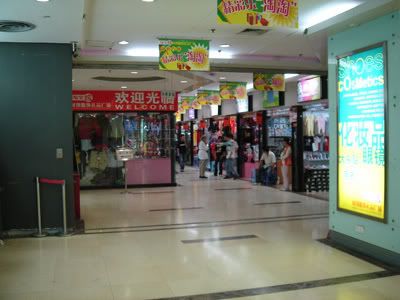
After shopping, we went down to our main sightseeing area for the night at Nanjing East road. As my friend has only visited the famous Nanjing East road during the day, I told him the night scene is many times better than the day.
The city central is full of lights and sounds. With performances like the one going on below. It showcases the olden Shanghai 1930s performance.
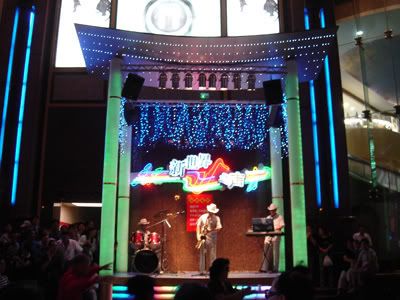
It is down to the shopping street with all the neons lights flashing around.
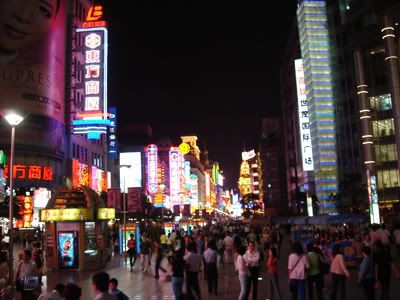
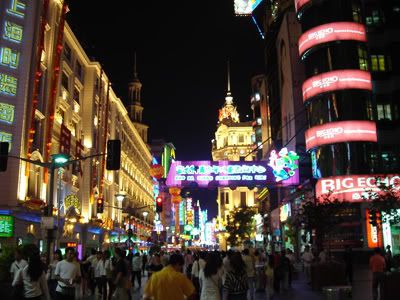
Here we have the thermometer again. The weather now is quite pleasant and it feels like air-con wherever we go, as compared to winter the last time we were here.

Finally we arrived at main Shanghai viewpoint.
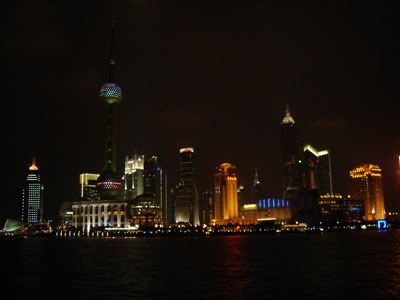
This time round, I intend to cross over and see what is there.
We took the Bund sightseeing tour which cost around 30RMB per person.
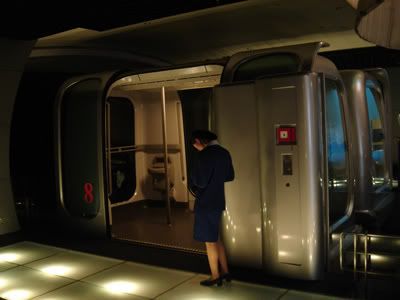
The ‘tour’ is just a guided car driven through a tunnel full of laser lights.
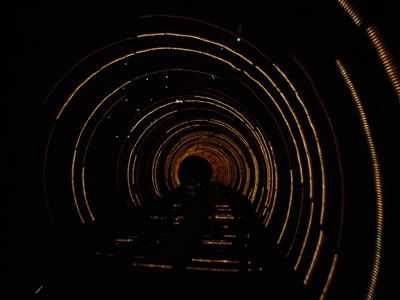
We arrived opposite and see all the sights from up close. I came to realize that here is the actual financial hub of Shanghai city. There are towering skyscrapers all around us and it looks all new and modern. Wide boulevards and modern architectural designs make you feel as if this is not China. It looks very similar to Odaiba of Japan, a modern futuristic city with a television station. Anyone who want to see modern China should visit the this part of Shanghai, it is many times larger than the financial centre of Singapore.
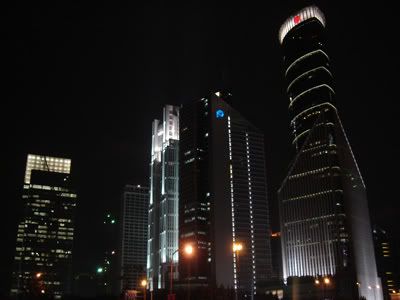
I am quite fascinated by this skyscraper which is currently the tallest structure in Shanghai. Though it is only 88 stories high, but it feels as if it is reaching for the sky.
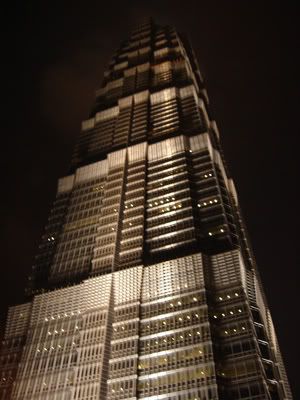 And finally we bid farewell to Shanghai city at 8.30pm and be on our way back to the airport.
And finally we bid farewell to Shanghai city at 8.30pm and be on our way back to the airport.

























































